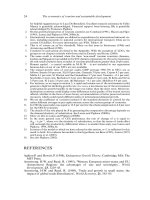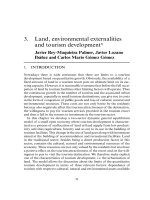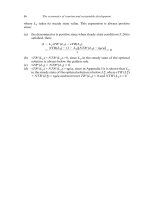THE ECONOMICS OF MONEY,BANKING, AND FINANCIAL MARKETS 185
Bạn đang xem bản rút gọn của tài liệu. Xem và tải ngay bản đầy đủ của tài liệu tại đây (43.43 KB, 1 trang )
CHAPTER 7
A PP LI CATI O N
Stocks, Rational Expectations, and the Efficient Market Hypothesis
153
The Efficient Market Hypothesis
Suppose that a share of Microsoft had a closing price yesterday of $90, but new
information was announced after the market closed that caused a revision in the
forecast of the price next year to go to $120. If the annual equilibrium return on
Microsoft is 15%, what does the efficient market hypothesis indicate the price will
go to today when the market opens? (Assume that Microsoft pays no dividends.)
Solution
The price would rise to $104.35 after the opening.
P of
t
R of
1
Pt
Pt
C
R*
where
R of
R*
P tof
1
Pt
C
optimal forecast of the return 15%
equilibrium return 15%
optimal forecast of price next year
price today after opening
cash (dividend) payment
Thus
0.15
0.15
P t (1.15)
Pt
Pt
Rationale
Behind the
Theory
0.15
0.15
$120
0
$120 Pt
Pt
$120 Pt
$120
$104.35
To see why the efficient market hypothesis makes sense, we make use of the concept of arbitrage, in which market participants (arbitrageurs) eliminate unexploited profit opportunities (i.e., returns on a security that are larger than what
is justified by the characteristics of that security). There are two types of arbitrage,
pure arbitrage, in which the elimination of unexploited profit opportunities
involves no risk, and the type of arbitrage we discuss here in which the arbitrageur
takes on some risk when eliminating the unexploited profit opportunities.
To see how arbitrage leads to the efficient market hypothesis, suppose that,
given its risk characteristics, the normal return on a security say, Nexen common
stock is 10% at an annual rate, and its current price Pt is lower than the optimal
forecast of tomorrow s price P oft 1 so that the optimal forecast of the return at an
annual rate is 50%, which is greater than the equilibrium return of 10%. We are now
able to predict that, on average, ExxonMobil s return would be abnormally high, so
that there is no unexploited profit opportunity. Knowing that, on average, you can
earn such an abnormally high rate of return on ExxonMobil because
R of
R *, you would buy more, which would in turn drive up its current price
Pt relative to the expected future price P oft 1, thereby lowering R of. When the









